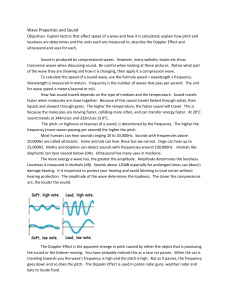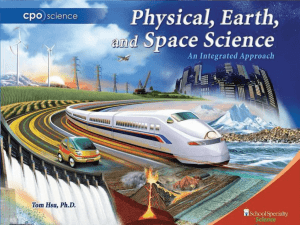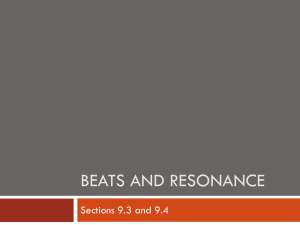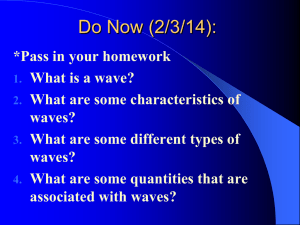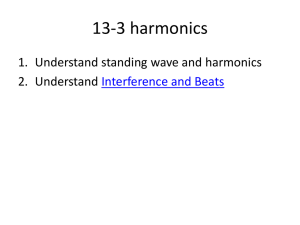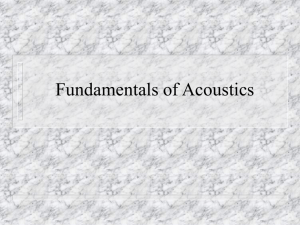sound pitch loudness doppler effect notes
advertisement
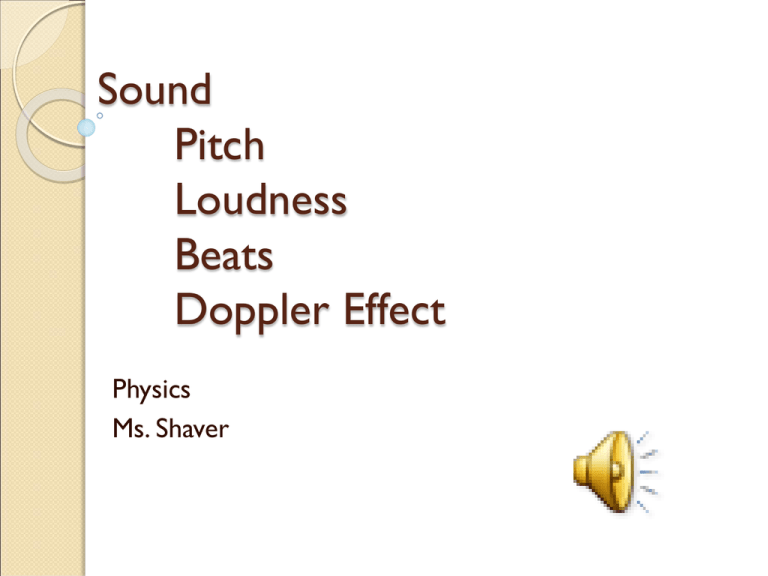
Sound Pitch Loudness Beats Doppler Effect Physics Ms. Shaver Sound Sound is a longitudinal mechanical wave aka a pressure or compression wave Compressions(High Pressure) Rarefactions(Low Pressure) Sound Tiny hairs inside the inner ear (cochlea) translate air pressure into electrical impulses that can be read by the brain Graphing Sound Speed of Sound Depends on the medium. The more elastic the medium the faster sound will travel through it. Speed in metals>speed in water>speed in air Sound can’t travel through vacuum. Speed of Sound in Air v = 331 + 0.6 T ( in meters/sec) T is the temperature in 0C. In higher humidity, sound will travel faster. For 15°C, v = 331 + 0.6*15 = 340 m/s Use 340 m/s as an average speed of sound in air. Faster than the speed of Sound Supersonic – motion faster than speed of sound Sonic boom – caused by an object breaking the sound barrier (supersonic planes, bullets) Plane reaches speed above 770 mph – Explosion of sound waves caused by air crashing behind the plane The air can condense or sweep up vapor from engine – causing this picture Pitch: the frequency of a sound wave. Musical notes have a given pitch. The note C has a frequency of 327Hz. When two notes differ by a ratio of 2:1 they are one octave apart. What would be the next higher C? (Ans:654Hz) Pitch – frequency of sound wave Humans can hear frequencies between 20 Hz and 20,000 Hz Infrasonic frequencies: Below 20 Hz ◦ used by elephants and submarines to communicate over long distances Ultrasonic frequencies ◦ Dog whistles Loudness = Amplitude Loudness is measured in decibels (dB) A +10 dB change we hear as twice as loud A -10 dB change we hear as half as loud Decibels – Loudness measure EXAMPLE: If a sound is 20 dB loud, answer how many dB these would be: 1) A sound twice as loud: 30 dB A sound half as loud: 10 dB A sound three times as loud: 35 dB 2) 3) Decibels – Loudness measure Examples of Sound Intensity Levels jet plane taking off air raid siren threshold of pain loud rock music ear damage starts busy traffic normal conversation quiet library soft whisper threshold of human hearing 140 dB 125 dB 120 dB 115 dB 85 dB 70 dB 60 dB 40 dB 20 dB 0 dB Timbre – tone quality What makes a particular musical sound different from another, even when they have the same pitch and loudness EX: difference between a guitar and a piano playing the same note at the same loudness Sounds can be described in terms of “coloration,” e.g. bright, dark, warm, harsh, etc. Timbre – tone quality Color of the note is due to the presence of different harmonics. The “oo” has mostly low harmonics, while the “ee” has mostly high harmonics Harmonics - Review v = λ f - The velocity of the wave stays the same, even if considering different harmonics….it’s still the same wave!!! Harmonics - Review Properties of Sound Reflection (Echo) Refraction Interference Diffraction Echoes Echoes are sounds that are reflected back by a hard boundary. Echoes Echolocation – used by many animals like bats to see through dark water or at night Sonar – sound through water Radar – light waves through air Sonograms – sound waves through the human body Beats Interference effect When two waves of close frequencies interact causing alternating constructive and destructive interference Beats The number of beats = difference of two frequencies (absolute value) EX: f1 = 345 Hz; f2 = 342 Hz ◦ Number of beats = 345 – 342 = 3 ◦ There will be three beats per second http://www.school-forchampions.com/science/sound_beat_frequencies.htm#.U2gpwletJW8 Bow (Shock) Waves When the speed of a moving sound source is greater than the speed of the wave, a pressure ridge builds similar to the wave created by the bow of a ship. physlet animation Sonic Boom When the pressure ridge of a bow wave of a jet passes over an observer on the ground, the observer experiences a sonic boom. Doppler Effect The change in a wave's perceived frequency due to the motion of either the sound source or the observer. It is applicable to any type of wave. Austrian physicist Christian Doppler (1803-1853). train sound clip Simulations physlet animation http://www.walter-fendt.de/ph14e/dopplereff.htm The Doppler Effect http://www.physicsclassroom.com/Class/sound/u11l3b.cfm The Doppler Effect In front of the source the sound waves are compressed (shorter wavelength λ) and this raises the frequency (pitch) Behind the source the sound waves are stretched (longer wavelength λ) and this drops the frequency (pitch) Anything moving at the same speed as the source will experience no change in frequency



